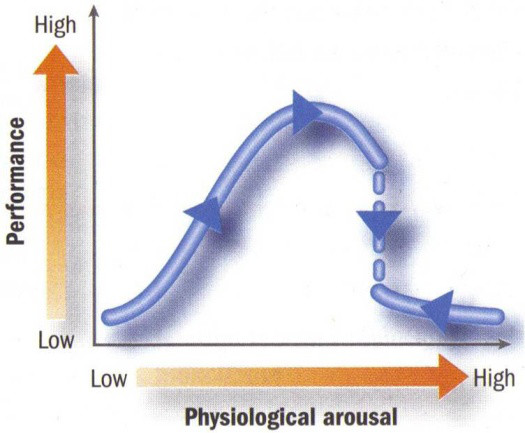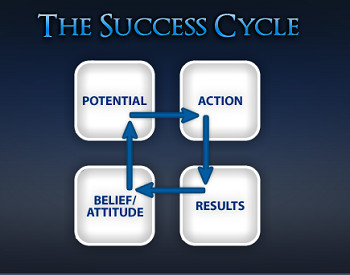It’s the commonest story at the 19th hole. At one end of the room, some poor golfer is saying
"My front nine was awesome today, then I blew up and didn’t make a point on the back nine."
Across the room, some other poor golfer is baffled.
"I couldn’t hit a barn door on the front nine today, then I just gave up and started playing really well on the back. I May have won the tournament if I could have made a point on the front nine”.
What is really happening here? Does our entire swing change mid round? Professionals take years to change their techniques enough to notice improvements, how could ours change so dramatically from the ninth hole to the tenth? What can we learn from these dilemmas?
 While there can be many different causes for this, I believe that in most cases it is mental. Tony Robbins coined a term (I don’t know if he was the first to describe it) called the ‘Internal Thermostat’. The theory goes that, as we go outside of our comfort zone into new territory, our subconscious will make attempts to get us back to where we know is safe – what we believe is ‘our level’. This makes sense in evolutionary terms. Any being that would push the boundaries too much may find themselves in trouble, or eaten/killed and taken out of the gene pool.
While there can be many different causes for this, I believe that in most cases it is mental. Tony Robbins coined a term (I don’t know if he was the first to describe it) called the ‘Internal Thermostat’. The theory goes that, as we go outside of our comfort zone into new territory, our subconscious will make attempts to get us back to where we know is safe – what we believe is ‘our level’. This makes sense in evolutionary terms. Any being that would push the boundaries too much may find themselves in trouble, or eaten/killed and taken out of the gene pool.
Reaching for more could be costly. We have in built subconscious mechanisms which stop us from reaching too far, and stop us from not reaching enough.
So, if you are shooting your best ever score, and you know it, you may find that you begin to self sabotage. You may feel like you get a few ‘bad bounces’ or a few more putts lip out than normal. Maybe you hit a snap hook at the wrong time – is this coincidental, or is something deeper going on? After your front nine, maybe you have shot your best score by 2 or 3 shots. You were completely unaware up until that point as to how good you were doing. Now you realize, "I could shoot my record here”.
Now your internal thermostat kicks in
 Adrenalin begins to flow. When adrenalin is in the system, we tend to have a heightened awareness of perceived danger – bunkers become bigger, greens become smaller and water becomes wetter in our mind.
Adrenalin begins to flow. When adrenalin is in the system, we tend to have a heightened awareness of perceived danger – bunkers become bigger, greens become smaller and water becomes wetter in our mind.- Your thoughts turn to maintaining your score, rather than pushing the boundaries further. You start to think about just getting into the clubhouse safely.
- Your expectations skyrocket – “I played so great last nine holes, every shot was good. I should be able to do the same for the next nine”
- Your mind wanders into the future, trying to imagine what holes could be problems for you
- You mind starts bringing up images of poor shots you have hit in the past on this hole
- Your swing completely loses its feel. You tighten up and can’t seem to get that same swing feeling again. In an attempt to try and get it back, you start thinking analytically about your swing. That doesn’t work, so you add another thought, and another, until you are a complete mess.
An entire industry has been made on trying to do this. Sports psychologists tell us to focus on our routine, stay in the present, don’t think about score, relax your body, stop thinking too many swing thoughts, lower adrenalin through breathing exercises etc. While these are all valuable, how much of this is really getting to the issue?
- Change your perception – excitement not fear
- Physical tools to calm ourselves down
- Better routine – more process focus
- Less awareness on score
- Play without expectations
- Better visualization pre-shot
Let’s look at an example – If you have a hungry tiger in front of you staring you down, would focusing on breathing really even work? How about trying to just ‘relax’? Could you deceive yourself and say that you are excited to see this tiger, rather than fearful? Maybe try focusing less on the tiger – good luck with that. Perhaps visualizing the tiger as a big pussycat might help? I don’t think you would have much success getting that image of him eating you out of the way to create this new image. Yes, it is true, all of the above advice can help alleviate some of the stress. They are important tools in helping break through a barrier, but you can’t patch over the big problem with a few band aid mental tools. You need to get to the root of your problem – your internal thermostat, your belief system, your subconscious self image. You need to create a new internal set-point
 Luckily, a zookeeper comes along and takes the tiger away. Phew! All the symptoms of stress go away and you instantly relax. But wait, the zookeeper didn’t look afraid. He wasn’t displaying any symptoms of stress. He didn’t even have to try and relax himself through a breathing technique, or visualize a good image, or focus less on the tiger. In fact, he was more focused on the tiger, he was the one who had to collect it.
Luckily, a zookeeper comes along and takes the tiger away. Phew! All the symptoms of stress go away and you instantly relax. But wait, the zookeeper didn’t look afraid. He wasn’t displaying any symptoms of stress. He didn’t even have to try and relax himself through a breathing technique, or visualize a good image, or focus less on the tiger. In fact, he was more focused on the tiger, he was the one who had to collect it.
The situation was the same for us and the zookeeper, yet the reaction was completely different. The zookeeper has a completely different belief system, and his internal thermostat is different, as he has experienced this many times before.
So, if you find yourself stumbling after a good front nine, or losing it at the end of your round when you get close to your record, the answer to your problems are likely mental. Sure, applying some principles offered by sports psychologists can certainly help, but you may struggle to do them in practice. The real answer is in hitting the root cause – what is happening below your awareness. If you hit the root cause, every other symptom will dissolve away synergistically. This can be applied to most things in life just as well as it can to golf.

